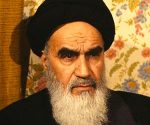 Ruhollah Khomeini, better known in the West as the Ayatollah Khomeini (1902-1989) was the de facto leader of Iran between 1979 and 1989. Born Ruhollah al-Musavi in a village south of the capital Tehran, he was raised by his older brother after their father was killed. Ruhollah received a conservative Islamic education, first from his brother, then from fundamentalist imams. In the 1920s he became interested in politics and adopted the name Khomeini, the name of the village where he was born and raised. At the age of 27, Khomeini married a 10-year-old girl; they had the first of five children three years later. During the 1930s he gained a reputation as an Islamic scholar, giving lectures and drawing followers to his mosque in Qom, about 80 miles south of Tehran. Khomeini’s lectures were usually critical of Iran’s national leaders, who he considered too secular and too closely aligned with the West.
Ruhollah Khomeini, better known in the West as the Ayatollah Khomeini (1902-1989) was the de facto leader of Iran between 1979 and 1989. Born Ruhollah al-Musavi in a village south of the capital Tehran, he was raised by his older brother after their father was killed. Ruhollah received a conservative Islamic education, first from his brother, then from fundamentalist imams. In the 1920s he became interested in politics and adopted the name Khomeini, the name of the village where he was born and raised. At the age of 27, Khomeini married a 10-year-old girl; they had the first of five children three years later. During the 1930s he gained a reputation as an Islamic scholar, giving lectures and drawing followers to his mosque in Qom, about 80 miles south of Tehran. Khomeini’s lectures were usually critical of Iran’s national leaders, who he considered too secular and too closely aligned with the West.
When the Shah of Iran announced a program of reform and modernisation in the early 1960s, Khomeini escalated his anti-government rhetoric, calling for an Islamic revolution. In March 1963 his school in Qom was raided by the Shah’s paratroopers and 18 people were killed. Khomeini was arrested twice, jailed and banished from the country. While in exile he smuggled fundamentalist literature and recorded lectures back to his followers in Iran. Khomeini was an Islamic fundamentalist who sought a national government determined by religious theology. His sermons were littered with conspiracy theories, anti-Semitism and anti-Western sentiment. As domestic opposition to the Shah grew in the late 1970s, so too did Khomeini’s profile and popularity. In January 1979 the Shah was forced to flee, allowing Khomeini’s return from exile a fortnight later.
Now aged 77, Khomeini became the supreme leader of a religious and political revolution. By the end of 1977, he had the support of the people, the backing of the military and a constitution reforming Iran as an Islamic republic. Khomeini also escalated his anti-American rhetoric, calling the United States the “Great Satan”. In October 1979 Washington allowed the former Shah into the US for medical treatment. This outraged Khomeini’s young followers, who formed a mob, stormed the US embassy in Tehran and took 52 Americans hostage. The Iran hostage crisis lasted almost 15 months and placed considerable pressure on US president Jimmy Carter. Khomeini and his government were demonised in the Western media. The US consequently provided military and financial aid to Iraqi leader Saddam Hussein during the Iran-Iraq War (1980-1988).
Under Khomeini’s rule Iranians were subject to Sharia law, strict dress codes, Islamic education and the suppression of political and religious minorities. In early 1989 Khomeini issued a fatwa (religious edict) that called for the assassination of British writer Salman Rushdie, purportedly for blaspheming against Islam. Khomeini died a few weeks later, aged 86, after two years of poor health.
Content on this page is © Alpha History 2018. This content may not be republished or distributed without permission. For more information please refer to our Terms of Use.
This page was written by Jennifer Llewellyn and Steve Thompson. To reference this page, use the following citation:
J. Llewellyn & S. Thompson, “Ayatollah Khomeini”, Alpha History, accessed [today’s date], https://alphahistory.com/coldwar/ayatollah-khomeini/.
